If you are tired of living with excessively large and uncomfortable breasts, you should consider breast reduction surgery. Large or “hypertrophic” breasts are not only the source of shoulder, back, and neck pain, but they can interfere with daily activities such as exercise, as well as make it difficult to find clothes that fit. More importantly, excessively large breasts can cause a woman to feel self-conscious and make her the object of unwanted comments or attention. Contact our Dallas, TX practice to discuss your breast reduction procedure with Dr. Pin.
Benefits of Breast Reduction
Breast reduction surgery is unusual in that it is both a reconstructive and a cosmetic procedure. Patients experience both symptomatic relief and improvement in functional status through the reduction in the size of the breasts, while at the same time, breast reduction surgery lifts a woman’s breasts, dramatically improving their shape and appearance.
Who Is a Good Candidate for Breast Reduction?
The ideal candidate for a breast reduction is a patient who has a relatively normal body weight for her height. Patients should be in good health and absolutely not be smokers. Smoking interferes with the blood supply to the breast and can result in significant wound healing problems, and potentially loss of the nipple. During your consultation, the different methods of breast reduction will be discussed to determine which is best suited for you. At the same time, Dr. Pin will go over what size preferences you have so the operation can be tailored to you.
The Fate of the Nipple in Breast Reduction
Women with large breasts are often interested in a breast reduction to improve their breast size but are reluctant to do so because they believe that the nipple and areola are entirely removed and replaced as part of the procedure. Fortunately, this is seldom necessary.
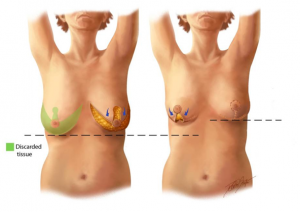 The purpose of a breast reduction is to treat overly large breasts by removing excess skin and breast tissue and elevating the nipple and areola. The amount of breast tissue removed can be modified to address a woman’s preferences. As a rule, the nipple is not removed with a breast reduction. Rather than removing the nipple and reattaching it, the surgeon usually “transposes” it or slides it upward to a more youthful position. The areola is also reduced in diameter. The surrounding skin is lifted and re-draped, while the nipple and areola remain attached to the underlying breast tissue. Following nipple elevation, there is an incision around the areola that makes it look like the nipple and areola were removed entirely and sutured back on. This incision is what misleads patients into believing the nipple is removed. By keeping the nipple attached to the breast in this manner, sensation to the nipple should be preserved. Besides preserving sensation, the patient's ability to breastfeed should also be unaltered following a breast reduction. This allows future mothers to whom breastfeeding is important to consider breast reduction surgery a reasonable procedure.
The purpose of a breast reduction is to treat overly large breasts by removing excess skin and breast tissue and elevating the nipple and areola. The amount of breast tissue removed can be modified to address a woman’s preferences. As a rule, the nipple is not removed with a breast reduction. Rather than removing the nipple and reattaching it, the surgeon usually “transposes” it or slides it upward to a more youthful position. The areola is also reduced in diameter. The surrounding skin is lifted and re-draped, while the nipple and areola remain attached to the underlying breast tissue. Following nipple elevation, there is an incision around the areola that makes it look like the nipple and areola were removed entirely and sutured back on. This incision is what misleads patients into believing the nipple is removed. By keeping the nipple attached to the breast in this manner, sensation to the nipple should be preserved. Besides preserving sensation, the patient's ability to breastfeed should also be unaltered following a breast reduction. This allows future mothers to whom breastfeeding is important to consider breast reduction surgery a reasonable procedure.
The Breast Reduction Procedure
There are many different techniques available to reduce breast tissue. Your plastic surgeon can discuss them with you and find the one that suits your particular situation the best. The most common procedure involves an incision around the areola that extends downward, following the breast’s natural curves. Excess tissue is removed and the nipple and areola are moved to the new position. Skin from both sides of the breast is brought down around the areola to reshape the breast.
The procedure itself is done under general anesthesia, either as an inpatient or an outpatient, depending on your size and preference. The procedure takes about two hours. Some of our breast reduction patients opt to undergo liposuction or tummy tuck in combination with breast reduction surgery.
Breast Reduction Before and After Photos
Featured Cases
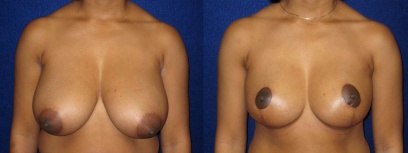
Breast Reduction
This 29 year old thought her 38DDD breasts were too large for her 5'0" 133-pound frame. Following a bilateral breast reduction she feels more comfortable in a C cup.
+ See Full Case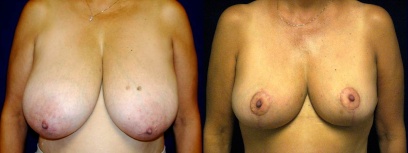
Breast Reduction
This 60-year-old women was plagued with breasts that pulled on her back and shoulders while also making her look overweight.
+ See Full Case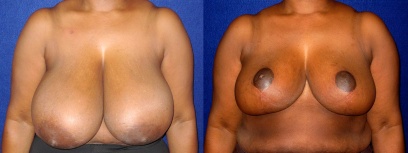
Breast Reduction
This 52 year old had massive breast hypertrophy and wanted relief from her symptoms of back and shoulder pain. She was 5'2" and 180 pounds at the time of her surgery.
+ See Full Case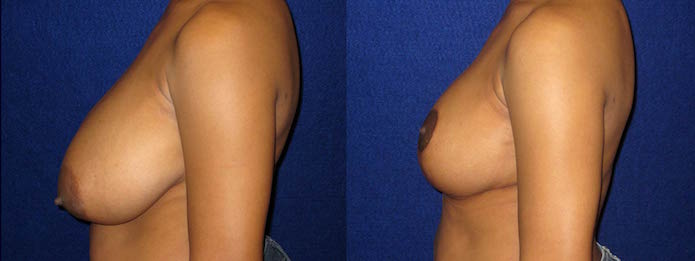
DDD-cup to a C-cup: This patient is a classic case in which the breasts are too large for her frame. The Before image shows that the breasts have become elongated and droopy. In addition, the nipples and areolas not only point down but have fallen below the line of the inframammary crease. In the After images, the breasts have been restored to a fuller, round shape with a nipple structure that points straight ahead instead of down.
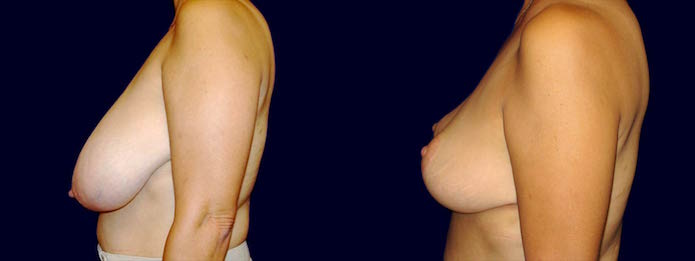
60-year-old Patient: In this case, not only are the breasts very large, but they have also become extremely elongated. For this patient, Dr. Pin performed a lift and reduction technique to reposition the breasts higher on the chest wall while reducing their size. The After picture shows that the breasts have been restored to a fuller, more rounded shape that sits higher on the chest.
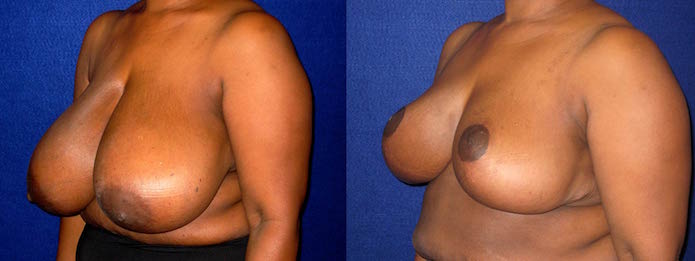
1200 grams of tissue removed: This is an extreme example of overly large breasts (hypertrophy). As a result, the patient suffered from serious back and shoulder problems. The before photo shows that the breasts not only have drooped far below the inframammary crease, but that the nipple structure points directly down. Once she had more than 1,200 grams of breast tissue removed, her symptoms considerably improved.
Breast Reduction Recovery
Recovery following breast reduction is much easier now due to improved techniques. All sutures are dissolvable and therefore do not need to be removed. Surgical adhesive covers the incisions, so there are no bandages to change. When Dr. Pin does your breast reduction, you will simply wear your normal clothing and be able to bathe on the first post-operative day. Additionally, you will be significantly smaller! Most patients can return to the office in 10 days and resume exercise in two weeks. Symptoms referable to large breast size should dramatically improve. Though there are potential complications as with any surgical procedure, the vast majority of patients are ecstatic with their results. Less pain and discomfort, an easier time buying clothes, and greatly enhanced appearance make breast reduction one of the best procedures in plastic surgery.
Dr. Paul Pin has years of experience performing the breast reduction procedure; contact our Dallas office to schedule your breast reduction consultation with Dr. Pin.
